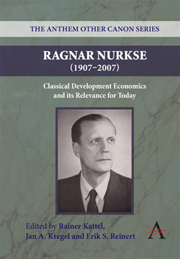Book contents
- Frontmatter
- Contents
- Preface
- Title in the series
- 1 The Relevance of Ragnar Nurkse and Classical Development Economics
- 2 Life and Time of Ragnar Nurkse
- 3 Nurkse and the Role of Finance in Development Economics
- 4 Early Development Theory from Sun Yat-sen to Ragnar Nurkse
- 5 The Roots of Unequal Exchange: Mihail Manoilescu and the Debate of the 1930s
- 6 Nurkse and the Early Latin American Structuralists: A Reflection on Development Theory, Industrialization and their Relevance Today
- 7 Lewis, the Long Wave and Industrialization in the Periphery
- 8 Ragnar Nurkse and the Law & Economics of Development
- 9 Ragnar Nurkse's Development Theory: Influences and Perceptions
- 10 Nurkse meets Schumpeter: Is Microfinance a ‘Silver Bullet’ to Economic Development?
- 11 Stockpiling of International Reserves and Development: a Misguided Link
- 12 International Currency Experience and the Bretton Woods System: Ragnar Nurkse as Architect
- 13 Some Reflections on Nurkse's Patterns of Trade and Development
- 14 India and Development Economics: External Influences and Internal Responses
- Notes
7 - Lewis, the Long Wave and Industrialization in the Periphery
Published online by Cambridge University Press: 05 March 2012
- Frontmatter
- Contents
- Preface
- Title in the series
- 1 The Relevance of Ragnar Nurkse and Classical Development Economics
- 2 Life and Time of Ragnar Nurkse
- 3 Nurkse and the Role of Finance in Development Economics
- 4 Early Development Theory from Sun Yat-sen to Ragnar Nurkse
- 5 The Roots of Unequal Exchange: Mihail Manoilescu and the Debate of the 1930s
- 6 Nurkse and the Early Latin American Structuralists: A Reflection on Development Theory, Industrialization and their Relevance Today
- 7 Lewis, the Long Wave and Industrialization in the Periphery
- 8 Ragnar Nurkse and the Law & Economics of Development
- 9 Ragnar Nurkse's Development Theory: Influences and Perceptions
- 10 Nurkse meets Schumpeter: Is Microfinance a ‘Silver Bullet’ to Economic Development?
- 11 Stockpiling of International Reserves and Development: a Misguided Link
- 12 International Currency Experience and the Bretton Woods System: Ragnar Nurkse as Architect
- 13 Some Reflections on Nurkse's Patterns of Trade and Development
- 14 India and Development Economics: External Influences and Internal Responses
- Notes
Summary
Introduction
W. Arthur Lewis is a canonical figure in economics and can be considered as one of the key thinkers in twentieth-century development thought. His output over more than a half century was voluminous and varied in subject matter. By the time of his Nobel Prize lecture, Lewis had authored ten books and 80 scholarly articles on topics as wide ranging as industrial economics, world trade, development planning, agricultural economics, race and economic development, education, politics, economic integration and economic history (Tignor 2006).
Lewis was a contemporary of Nurske. Both men were among a small group of theorists and analysts working on the problem of economic development in the 1950s. Strangely, there are little or no references to each other's work, even though there are clear areas of contention and synergy. For example, under what became known as the Lewis model of ‘industrialization by invitation’, the modernization of the peripheral economy would tend to favour the interest of foreign firms and the local elite whose tastes and ideologies are aligned to foreign consumption. On the other hand, Nurske's (1952) balanced growth thesis is critical of the view that productivity gains and increased savings can accrue to peripheral economies through external sources, for example, foreign investment. Indeed, Nurske argues that the problem is not just one of production, but of the widening gap between developed and developing countries and the problem of emulation of lifestyle and consumption. What Nurske is outlining is that development is a relational construct; it is always about invidious comparisons and it is always about filling gaps and catching up with the ‘leaders’.
- Type
- Chapter
- Information
- Ragnar Nurkse (1907–2007)Classical Development Economics and its Relevance for Today, pp. 147 - 166Publisher: Anthem PressPrint publication year: 2009
- 1
- Cited by

